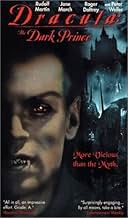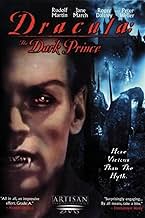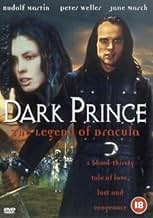VALUTAZIONE IMDb
6,0/10
2798
LA TUA VALUTAZIONE
Aggiungi una trama nella tua linguaThe dramatized story of Dracula, looking at the historic events rather than the Hollywood version.The dramatized story of Dracula, looking at the historic events rather than the Hollywood version.The dramatized story of Dracula, looking at the historic events rather than the Hollywood version.
- Regia
- Sceneggiatura
- Star
- Premi
- 1 candidatura in totale
Recensioni in evidenza
The only problem I had with this movie was the excessive and exaggerated use of the "shaky-cam". This can be an effective took, if used subtly. That was not the case in Dark Prince. I found it very annoying at times and once, it became down-right painful to watch. The good news is that its not always that bad. I enjoyed it and would recommend it for good acting, compelling story line, very good battle scenes, great sets and location shots, and captivating subject matter for those who want intelligent Halloween entertainment.
The movie deals with the so-called historical figure of Vlad Tepes (phonetically that is "Tzepesh" and it literally means "Impaler"), not the vampire of Bram Stoker but the tormented Wallachian (Romanian) medieval ruler that stood against the might of the Ottoman Empire with nothing but a few trained men of his own and his reputation as master of psychological warfare by means of sheer terror and unprecedented scale of prisoner execution through impalement (Google on that for detailed info). Vlad's father, also called Vlad, was a member of the Teutonic knightly order of the Dragon, which had been established in Germany with the purpose of protecting Christianity against the rise of Islam at the gates of Europe. His affiliation with this order gained him the surname "Dracul" which is a Romanian translation for "Dragon" and also a synonym for "devil". Vlad the Impaler, that is the son of Vlad Dracul, inherited his father's membership into the order of the Dragon, but because he was the son of Dracul, he was named "Draculea", or "Dracula", which means "son of Dracul", son of the Dragon, and ultimately son of the devil. His reputation as a mad executioner would be well justified by today's standards, although he was just a babe when compared to other rulers of his time (his own cousin, Stephen the Great, ruler of Moldavia, "the Athlete of Christ" as he had been named by the Pope for having repeatedly beaten the crap out of the Turks, had reportedly killed many more people through impalement than Vlad but because he had always been politically correct, he never went down into history as a deranged butcher). Vlad Tepes had the Saxons of Transilvania account for their transgressions against the conquered local Romanian population and it was because of the vengeful literate Germans who wrote exacerbated stories about him that he was later on remembered as the sadistic figure we now read of in the history books. He had also been ruthless with the breaking of the law in his own land. The only punishment instituted for whatever crime committed, regardless of its seriousness, was the one and only impalement. It's because of this that, during his reign, crime had reportedly dropped to nil. That is why, for the Romanians, he's still, up to this day, considered a national hero of special importance, unlike any other, because his name is called upon in times of great oppression, when corruption and plundering of the national economy by the oligarchic political class bring the common, ordinary citizens on their knees. When confronted with such disasters, Romanians cry out the verses of Mihai Eminescu (1850-1889), the greatest national poet of Romania, who had even written a poem in Tepes's honor which, in time, became a sort of a prayer for those crushed by the arrogance of the ruling class. In a few words, it goes something like this (in free translation):
"Where are you, lord Tepes / So that, by grabbing them / You would divide them in two packs: / Lunatics and scoundrels. / And in two large jails / You would forcibly gather them / And then set fire to the prison / And the madhouse."
(sounds much, much better in Romanian...lol :)))
"Where are you, lord Tepes / So that, by grabbing them / You would divide them in two packs: / Lunatics and scoundrels. / And in two large jails / You would forcibly gather them / And then set fire to the prison / And the madhouse."
(sounds much, much better in Romanian...lol :)))
This film is based on the known history of Vlad Tepes (Vlad the Impaler), son of Dracul (the name means either devil or dragon), who has come to be known through Bram Stoker's famous novel as Dracula. The film begins with Vlad confessing his life story to Greek Orthodox priests. He is caught in the weblike power struggles involving the Roman Catholic Church, the Greek Orthodox Church, Hungary, and the Moslem Turks. In the midst of all this, he tries to do what is best for his homeland.
The film illustrates the origins of the Dracula myth: blood drinking, impaling with stakes, fear of mirrors, rebellion against religion, and the doom of eternal life because he is cursed to be welcome in neither heaven nor hell. Vlad is presented historically as a Robin Hood freedom fighter, a George Washington of Romania, and a man who tries to bring peace and justice to his troubled land. Some see him as a Messiah while others believe he is the Anti-Christ. In some ways, Vlad can be viewed as a 15th Century Godfather.
The plot unfolds slowly but the movie is nicely photographed and well acted. Vlad himself is played as a moody, brooding, dark figure who easily gives life to the many legends that have become attached to his name.
This is another very well-executed TV-movie and is definitely worth watching. The fact that it premiered on Halloween night is appropriate because the atmosphere is quite spooky.
The film illustrates the origins of the Dracula myth: blood drinking, impaling with stakes, fear of mirrors, rebellion against religion, and the doom of eternal life because he is cursed to be welcome in neither heaven nor hell. Vlad is presented historically as a Robin Hood freedom fighter, a George Washington of Romania, and a man who tries to bring peace and justice to his troubled land. Some see him as a Messiah while others believe he is the Anti-Christ. In some ways, Vlad can be viewed as a 15th Century Godfather.
The plot unfolds slowly but the movie is nicely photographed and well acted. Vlad himself is played as a moody, brooding, dark figure who easily gives life to the many legends that have become attached to his name.
This is another very well-executed TV-movie and is definitely worth watching. The fact that it premiered on Halloween night is appropriate because the atmosphere is quite spooky.
This is a very loosely biographical based movie on Vlad Dracula, and it was a very refreshing change.
Roger Daltrey is the weakest actor, and he is pretty good.
Rudolf Martin was perfect for the role of Dracula, what a mix of passion, and vanity.
The story is fact based and if you know your history you can see it weaved though-out this tale. The sets are amazing for a fairly low budget movie.The fight scenes are fair to slightly above average, but this movie is so strongly written you can forgive the weaker fight scenes.
One of the Best Dracula movies I have seen, and by far the best low budget historical(ish) Vlad movie I have seen.
Roger Daltrey is the weakest actor, and he is pretty good.
Rudolf Martin was perfect for the role of Dracula, what a mix of passion, and vanity.
The story is fact based and if you know your history you can see it weaved though-out this tale. The sets are amazing for a fairly low budget movie.The fight scenes are fair to slightly above average, but this movie is so strongly written you can forgive the weaker fight scenes.
One of the Best Dracula movies I have seen, and by far the best low budget historical(ish) Vlad movie I have seen.
Some things...
1) Dracula's first wife (whose name has never been historically documented other than known to be a Transylvanian noblewoman) committed suicide in 1462, not 1464, when Dracula was already imprisoned by the King of Hungary anyway. Not sure why the film changed this, really.
2) The impalings... aren't accurate. The oiled stake is put in the buttocks and slowly moves out through the mouth. This takes days, the impalee dying a slow death. We don't see any actual impalings during the movie save one, and the guy slides down the stake like it's a flag pole.
3) While not necessarily portrayed as a nice guy, I was expecting a bit more brutality. Much of Vlad Tepes' acts are brushed aside in the framing story of Dracula being interrogated by the priests in 1476 as "stories" by Dracula himself and this just seems like a kind of cop-out. I realize we don't need to see Dracula cutting the breasts off of women and such, but there was PLENTY of more hard-hitting material that could have been put in there. Example: instead of Dracula just closing the doors and executing the boyars like he does in the film, wouldn't it be far more effective cinematically to follow what *really* happened and show Dracula and his men dragging the boyars to go and build (by themselves) Castle Dracula, which took years and basically worked the lot of them to death? Also would have been effective to show the scene of Dracula rounding up all the homeless and beggars into the grand hall, then having his men burn it to the ground. The only real story of Dracula that was included was the one with the golden goblet that wasn't touched by anyone... that's about it.
4) I realize it was done for dramatic purposes, but the film kept sticking Dracula's broth Radu in places/times he simply wasn't. Dracula was killed in 1476 by a man (a Turk) disguised as one of his own guards... in a MARSH somewhat near Snagov, not inside Snagov Chapel.
5) The ending is neither here or there... I'd rather they didn't go that route, but then the end of Vlad's life is a bit anti-climactic.
1) Dracula's first wife (whose name has never been historically documented other than known to be a Transylvanian noblewoman) committed suicide in 1462, not 1464, when Dracula was already imprisoned by the King of Hungary anyway. Not sure why the film changed this, really.
2) The impalings... aren't accurate. The oiled stake is put in the buttocks and slowly moves out through the mouth. This takes days, the impalee dying a slow death. We don't see any actual impalings during the movie save one, and the guy slides down the stake like it's a flag pole.
3) While not necessarily portrayed as a nice guy, I was expecting a bit more brutality. Much of Vlad Tepes' acts are brushed aside in the framing story of Dracula being interrogated by the priests in 1476 as "stories" by Dracula himself and this just seems like a kind of cop-out. I realize we don't need to see Dracula cutting the breasts off of women and such, but there was PLENTY of more hard-hitting material that could have been put in there. Example: instead of Dracula just closing the doors and executing the boyars like he does in the film, wouldn't it be far more effective cinematically to follow what *really* happened and show Dracula and his men dragging the boyars to go and build (by themselves) Castle Dracula, which took years and basically worked the lot of them to death? Also would have been effective to show the scene of Dracula rounding up all the homeless and beggars into the grand hall, then having his men burn it to the ground. The only real story of Dracula that was included was the one with the golden goblet that wasn't touched by anyone... that's about it.
4) I realize it was done for dramatic purposes, but the film kept sticking Dracula's broth Radu in places/times he simply wasn't. Dracula was killed in 1476 by a man (a Turk) disguised as one of his own guards... in a MARSH somewhat near Snagov, not inside Snagov Chapel.
5) The ending is neither here or there... I'd rather they didn't go that route, but then the end of Vlad's life is a bit anti-climactic.
Lo sapevi?
- QuizIn 2000, to promote the film's premiere, USA Network held a sweepstakes contest with a grand prize of $5,000 to the lucky person who can correctly identify five myths of Dracula as depicted in this film.
- Citazioni
Radu: You are going to kill me, aren't you?
Vlad Dracula: You are a traitor to your people. You betrayed our father!
Radu: I never betrayed our father! Besides, if it weren't for me, you'd still be in that Turk prison.
Vlad Dracula: You had that much influence over the Sultan? Even as a boy?
Radu: Especially as a boy.
- Colonne sonoreLa Scarpa My Faict Mal
Written by Bernard Solomon (as J. Baird) and Frank Gari (as F. Gari)
I più visti
Accedi per valutare e creare un elenco di titoli salvati per ottenere consigli personalizzati
Dettagli
- Data di uscita
- Paesi di origine
- Lingua
- Celebre anche come
- Dracula: The Dark Prince
- Luoghi delle riprese
- Aziende produttrici
- Vedi altri crediti dell’azienda su IMDbPro
Contribuisci a questa pagina
Suggerisci una modifica o aggiungi i contenuti mancanti















